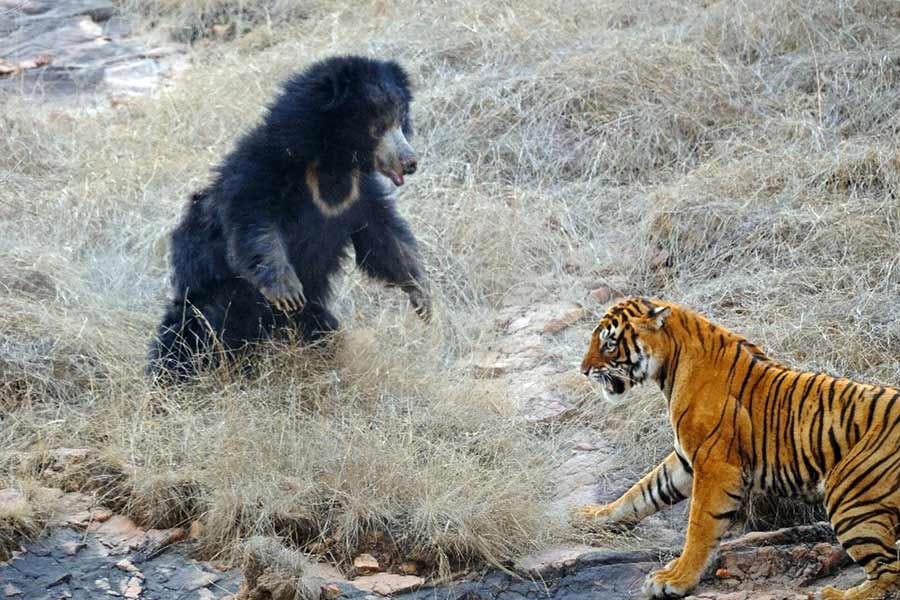In North America, full-grown bears are seldom forced to fight predators for their lives. But things are different for the sloth bear of the Indian subcontinent. The animals go head-to-head with some of the fiercest predators of all: tigers.
While the big cats are fearsome, they don’t find easy prey in the sloth bears, which are the size of a small black bear. For a study in the journal Ecology and Evolution published in July, researchers showed that tigers in India’s national parks easily sneak up on sloth bears, which often seem blissfully unaware that they are at risk of becoming cat food. But once the tiger strikes, the bears often manage to put the fearsome felines on the back paw.
The researchers hope the findings could help inform strategies to reduce conflict between humans and sloth bears, which are considered a vulnerable species.
Sloth bears are not themselves predatory. They live mostly on termites, ants and fruit. But they have developed fierce reputations of their own among people who share their habitats. Reports suggest they are responsible for more attacks on people than any large carnivore in the world.
Thomas Sharp, a wildlife ecologist with Wildlife SOS, an organization that works to conserve Indian wildlife, and an author of the study, has been asking local people why sloth bears are so aggressive since he started studying them 20 years ago.
“The answer I always got from people was ‘It’s because they fight with tigers,’” he said.
So he worked with colleagues to try to better understand sloth bear-tiger conflict. He and other researchers uncovered 40 videos and three photograph sequences taken by people on safari in India’s national parks that captured tigers searching for a sloth bear snack.
Sloth bears spend a lot of time digging and snorting with their heads down, searching for insects. “They make a lot of noise, and they’re not super aware,” Sharp said. And the tiger is a notoriously stealthy animal. This combination means the bears are easier to sneak up on.
They saw that the tigers often got very close before the sloth bears realized they were in danger — within 10 feet. But when bears did become aware of the threat, they were ready to fight. They would bolt up on their hind legs and swat at or charge the tiger. They also let out deep barking growls. The aggressive tactics worked, too. In the crowdsourced content, 86% of bears escaped unscathed.
In one of Sharp’s favorite videos, a tiger sneaks close enough to swat the bear’s back. “That’s so typical,” Sharp said. “And boy, once the bear turns, that tiger wants nothing to do with it.” The tiger leaps out of the way and its ears go back, looking more like a scolded house cat than a vicious predator.
While the sloth bear may not prefer to fight, it and the tiger live in an open landscape, which makes running and hiding difficult. Andrew Derocher, a bear researcher at the University of Alberta who wasn’t involved in the study, compares the finding with grizzly bears, which he says seem to become more aggressive in exposed terrain.
“Perhaps for a lot of the sloth bears, a good offense is the best defense,” he said.
Attacks on humans commonly occur when a sloth bear is startled at close range, just as with the tigers in the study. The bears also tend to stand up, swat and charge in a similar way. Sharp thinks it’s possible that sloth bears evolved an aversion to surprises from tigers — or possibly a different predator in the past — and that humans sometimes get caught in the crosshairs.
The researchers acknowledge that the videos posted online skew toward more dramatic encounters. Derocher agreed that there could be plenty of peaceful, less social-media-worthy interactions. But he noted that the videos highlighted how effective sloth bears were at defending themselves.
“It’s a nice natural history observation that makes good use of opportunistic information,” Derocher said.
Sharp said he continues to find new videos of sloth bears and tigers each year. While he respects the tiger’s role in the circle of life, having worked with sloth bears for so long, he admits he has picked a side on this natural battlefield.
“I get it: Nature is harsh,” he said. “But I do root for the bear to get away.”
The New York Times News Service










